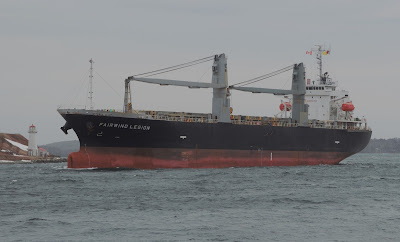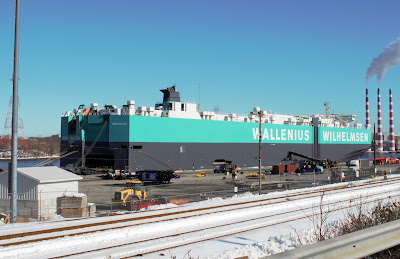Amongst the activity in Halifax harbour today, February 28, were several red ships. Not pictured here was the arriving CCGS Jean Goodwill returning from SAR patrol east. There was no room at the Bedford Institute so the ship tucked in at Pier 9C.
Also not pictured was the red hulled Oceanex Sanderling arriving from St.John's and anchoring in Bedford Basin instead of going directly to Autoport. Due to the delays at Autoport (see yesterday's post) the Wolfsburg was still tied up there. It sailed in the late afternoon and another auto carrier, Morning Peace, was given priority at the berth, and was alongside soon after.
Another red ship is the visiting research trawler CCGS Teleost which arrived yesterday from its home base in St.John's.
The Teleost occupied the berth usually used by the inshore patrol vessels, so the CCGS G. Peddle and CCGS Private Robertson VC have been moved to the C.O.V.E dock (former Cost Guard base). The Teleost - long overdue for replacement is instead going to drydock for another refit.
Another berth at the Bedford Institute was vacated this morning as the CCGS Kopit Hopson 1752 departed for sea trials. It first moved out into Bedford Basin, with the assistance of the navy tugs, CNAV Glenside and Merrickville. It later put out to sea, but didn't go very far. It went out as far as the harbour limit off Chebucto Head, then was back alongside at a different berth this afternoon.
Also seen in Bedford Basin today was the hydrographic researcn vessel John Cabot away from its home base of St.John's.
The 2672 gt vessel is the third of three ships built by Seaspan's Vancouver Shipyards under the National Shipbuilding Strategy and was delivered to St. John's in February 2021. Sister ship CCGS Capt Jacques Cartier, based in Halifax, arrived at the BIO in March 2020. It is currently in drydock at Pictou, NS. The first ship in the series, CCGS Sir John Franklin (ironically) is based on the Pacific coast. (Ironically because he never saw the Pacific despite several tries.)It was not all red in the harbour today, as one ship although showing a lot of red anti-fouling paint on the hull, was mostly black and white. The Fairwind Legion is of a familiar type, more usually seen with "Thorco" or "Fanbo" names.
Built in 2015 by Honda Shipyard in Saiki, Japan, it was indeed named Thorco Legion until 2020. A 13,100 gt, 16,957 dwt ship it carries two 50 tonne SWL cranes to work its box shaped holds.
In tracing the ship's recent movements, it seems that the ship has sailed from Asia in ballast. It was reported in Batangas, Philppines anchorage January 5-6, then Taichung, Taiwan January 9-10, Hong Kong anchorage January 10-12, thenpassed Cape Town Febraury 6-7/
Tying up at Pier 9B, it seems the ship will be fitted out with fiber-optic cable racks as its sister ships have done many times in recent years.
.






















































